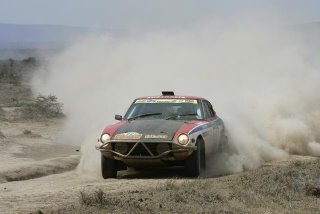 Em competições mais leves, como as de rallyes históricos de regularidade, os veículos não tem uma grande modificação, contudo, em rallyes da FIA de velocidade ou aqueles que mixam velocidade com regularidade, muitos itens são exigidos para dar segurança às equipes (piloto e navegador).
Em competições mais leves, como as de rallyes históricos de regularidade, os veículos não tem uma grande modificação, contudo, em rallyes da FIA de velocidade ou aqueles que mixam velocidade com regularidade, muitos itens são exigidos para dar segurança às equipes (piloto e navegador).O PASM analisa estes dados e modifica o amortecimento em cada roda. Isso resulta em redução de todos os movimentos da carroceria e em otimização do trabalho da suspensão em todas as rodas. Se o modo ‘Sport’ estiver selecionado, a suspensão ficará mais firme. Se a qualidade da superfície da pista piorar, o sistema altera imediatamente para um acerto mais macio dentro do modo “Sport” e restaura a tração e a aderência. Quando as condições da pista melhoram, o PASM faz a suspensão retornar à firmeza original.
No modo ‘Normal’, o PASM automaticamene deixa a suspensão mais firme (dentro das opções disponíveis nesse modo), ao detectar uma condução mais agressiva. Com isso, o carro responde da maneira mais apropriada e de maneira rápida ao comando do motorista. Os regulamentos FIA estão dispostos no site oficial (http://www.fia.com/sport/Regulations/histrally.html), onde o interessado pode ter uma idéia do que é obrigado a ter que mudar, como suspensão e freios, dentre outros itens, principalmente, se for um participante nas provas de rallye de velocidade. Suspensão, freios, pneus, gaiola, cintos de segurança e bancos, são itens mais sensíveis e que a FIA tem uma certa liberalidade no tocante à originalidade - tendo em mira sempre a segurança. Vide abaixo, os procedimentos standards no tocante aos carros de rallye histórico:
Os regulamentos FIA estão dispostos no site oficial (http://www.fia.com/sport/Regulations/histrally.html), onde o interessado pode ter uma idéia do que é obrigado a ter que mudar, como suspensão e freios, dentre outros itens, principalmente, se for um participante nas provas de rallye de velocidade. Suspensão, freios, pneus, gaiola, cintos de segurança e bancos, são itens mais sensíveis e que a FIA tem uma certa liberalidade no tocante à originalidade - tendo em mira sempre a segurança. Vide abaixo, os procedimentos standards no tocante aos carros de rallye histórico:1) The procedure must be initiated by an ASN, on request of the component manufacturer, or of another party with the formal agreement of the manufacturer.
2) The manufacturer of the replacement part will be responsible for obtaining any authorisation or licence which may be necessary in order to reproduce the original.
3) The FIA Historic Motor Sport Commission will appoint a Technical Commissioner to investigate. The Technical Commissioner will be a person who is either : an FIA Technical Delegate and/or member of the Technical Working Group, having an engineering background, or an independent expert involved in the engineering side of historic motoring.
4) When a component is to be submitted for recognition, the applicant must be informed, by the FIA through the ASN, of the procedure and costs involved.
5) Facilities must be provided, at the place of manufacture, for the Technical Commissioner to compare the new, finished component with an original, preferably unused, example of the period specification component authenticated by the ASN, and if possible the original manufacturer's production drawings.
The new component, along with the original component, will be scrutinised closely and the dimensions, weight and material of both components noted. Photographs, showing identical views of the new component and the original part from all sides, should be prepared. Examination of any engineering drawings of the component should be made and, if possible, copies obtained. If the component is a casting, then a view of and photographs of the pattern may be required.
6) This data will be assembled into a formal report to the Technical Working Group of the FIA Historic Motor Sport Commission, which will include the dossier of photographs, copies of the relevant drawings and should end with the Technical Commissioner's recommendations.
7) The Historic Motor Sport Commission will decide whether the component is eligible for use in international motor sport according to the requirements of Appendix K to the International Sporting Code : this recognition will concern solely the resemblance to the original component and will not constitute a guarantee or judgement of, or engage the FIA's responsibility in any way as to, the quality or safety in use of the component.
8) FIA-recognised components will be made identifiable by a code applied to them according to FIA instructions.
9) The Technical Commissioner will be entitled to any costs previously agreed with the FIA, as well as a fixed fee from the FIA, as decided by the FIA and not exceeding 230 Euros.
10) A standard fee will be charged to the applicant by the FIA, whether recognition is accorded or not.
11) Casting and machining tolerances:
Casting, external : ± 1.5mm.
Casting, internal : ± 2mm.
Machined part external : ± 0.5mm.
Luis Cezar
Nenhum comentário:
Postar um comentário